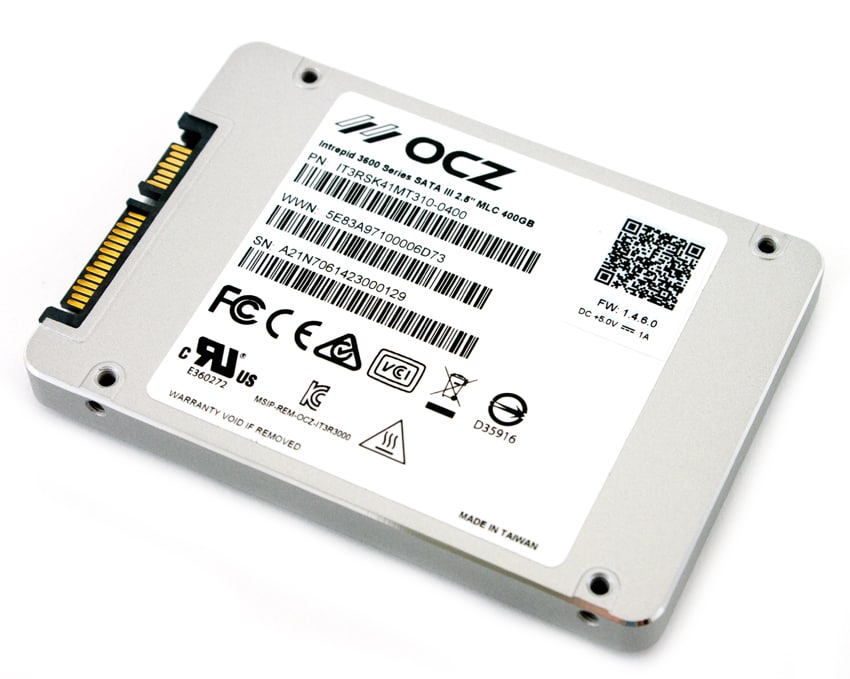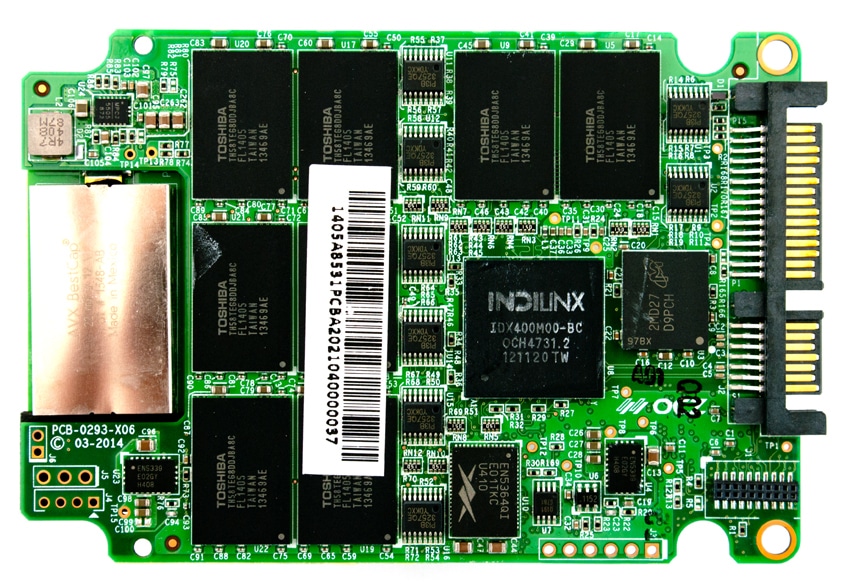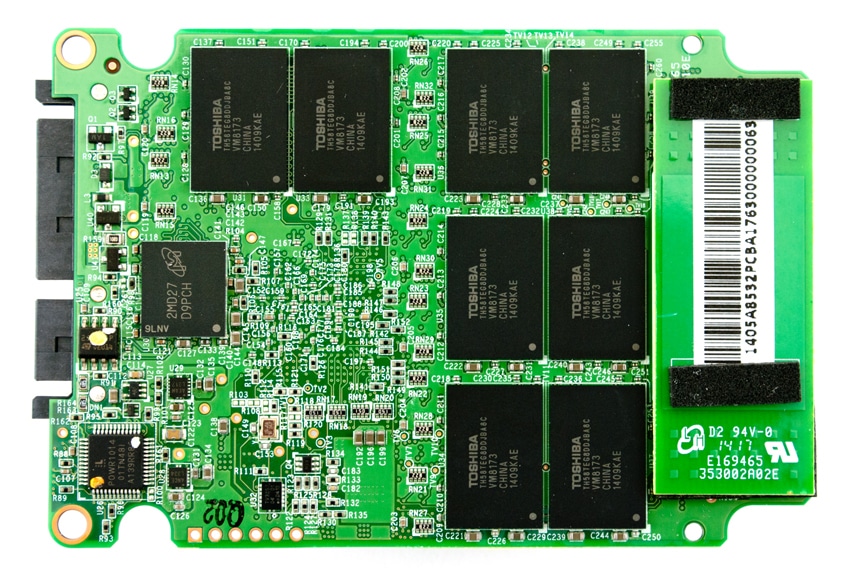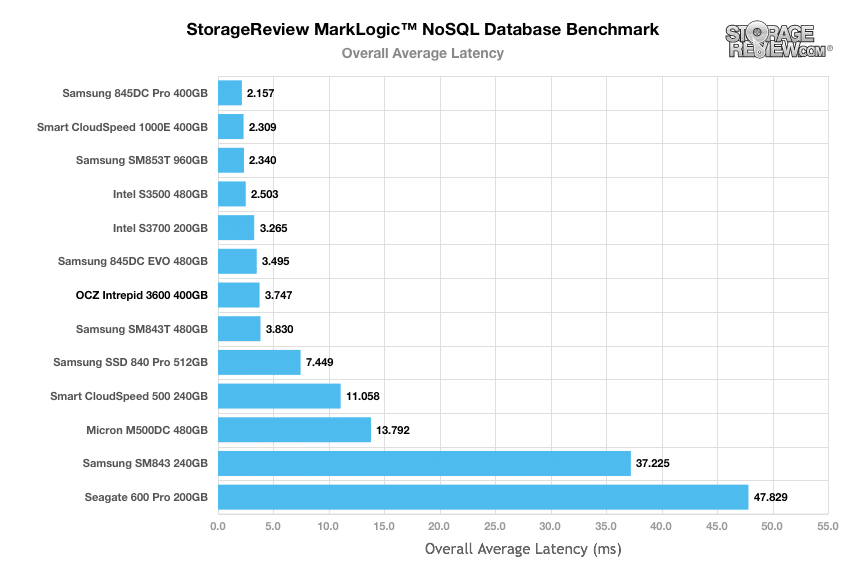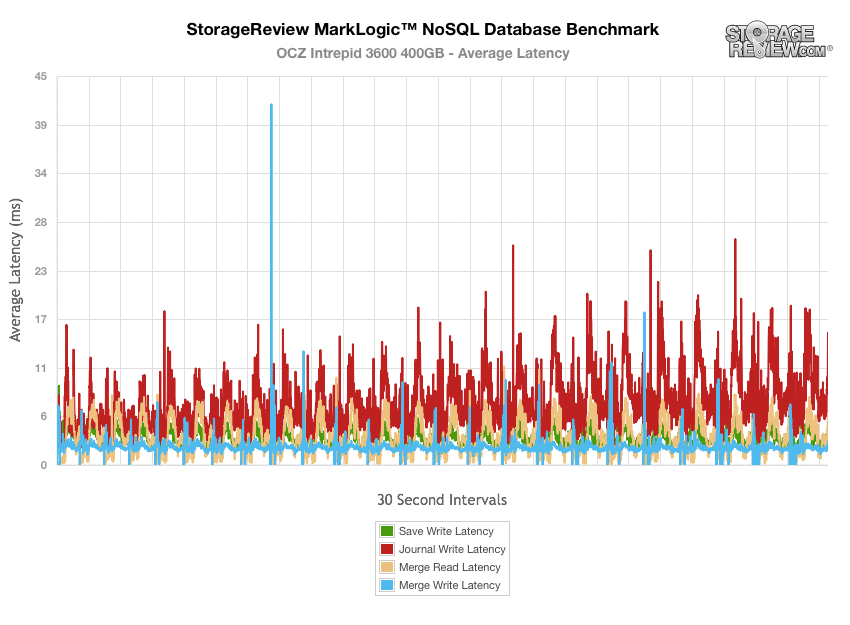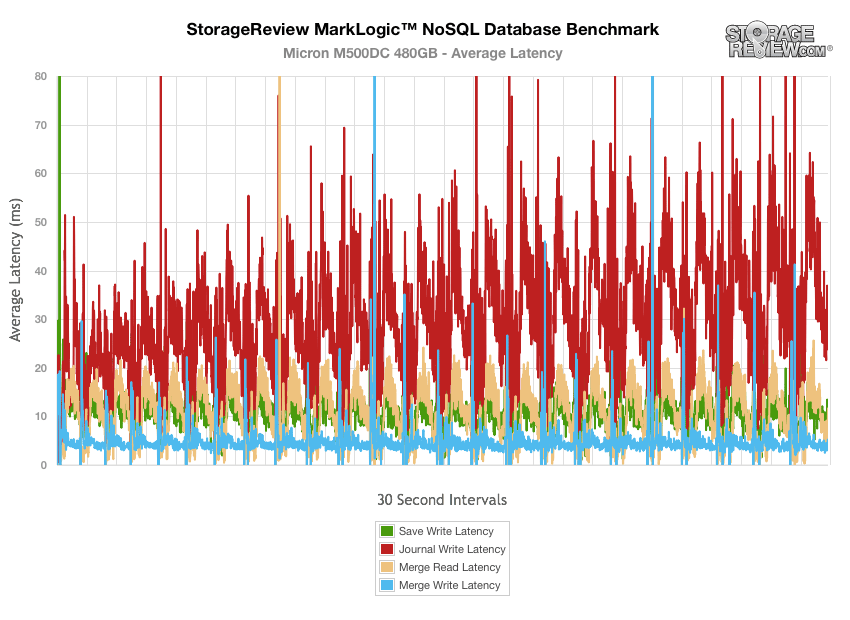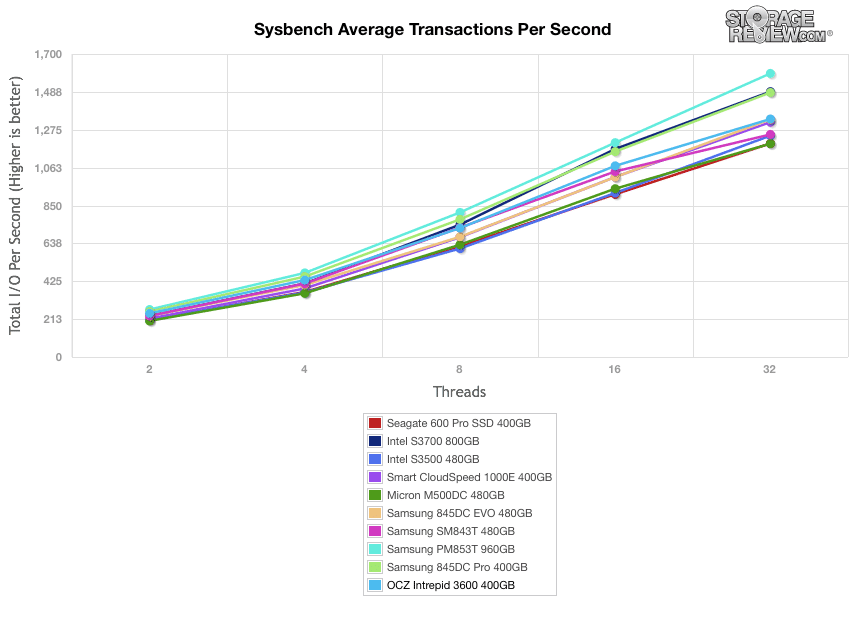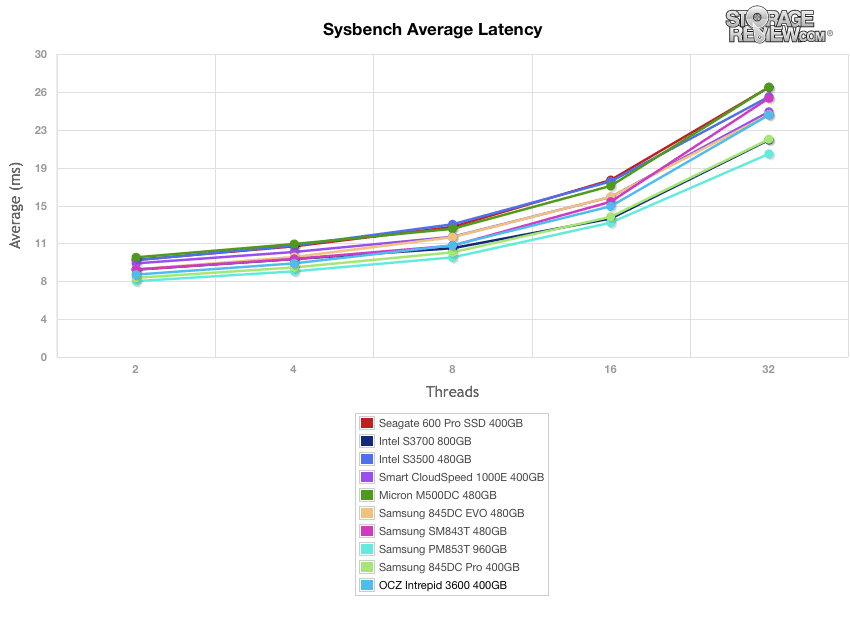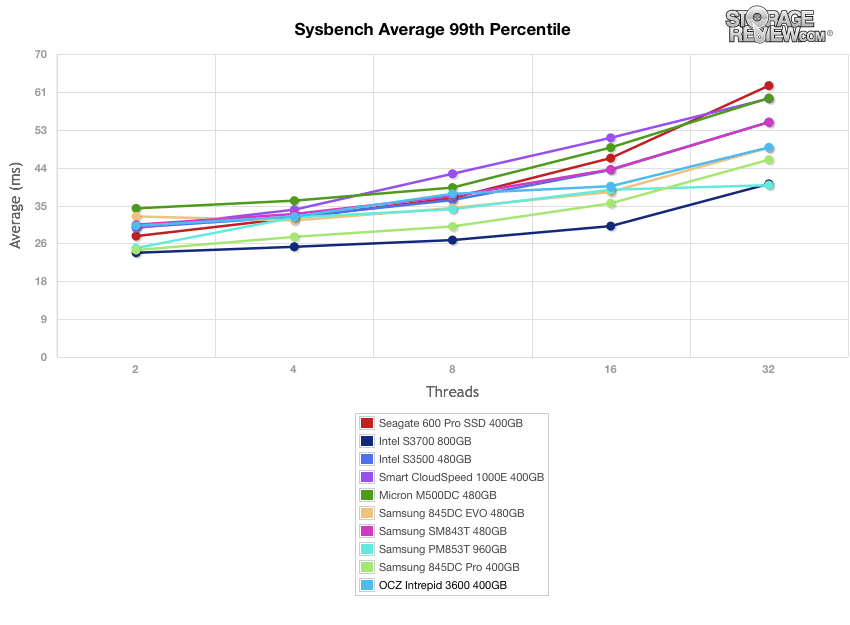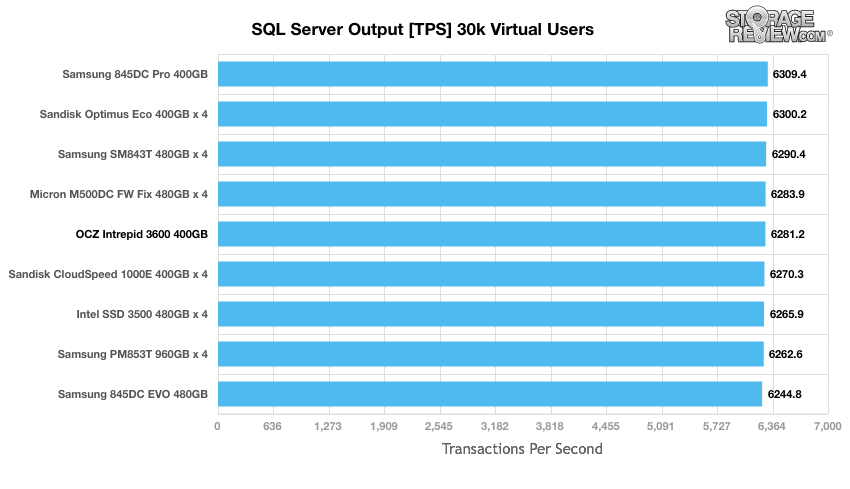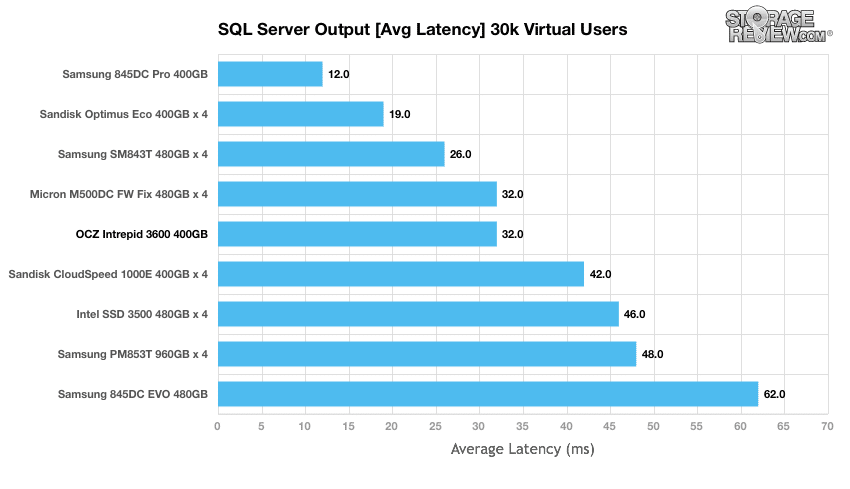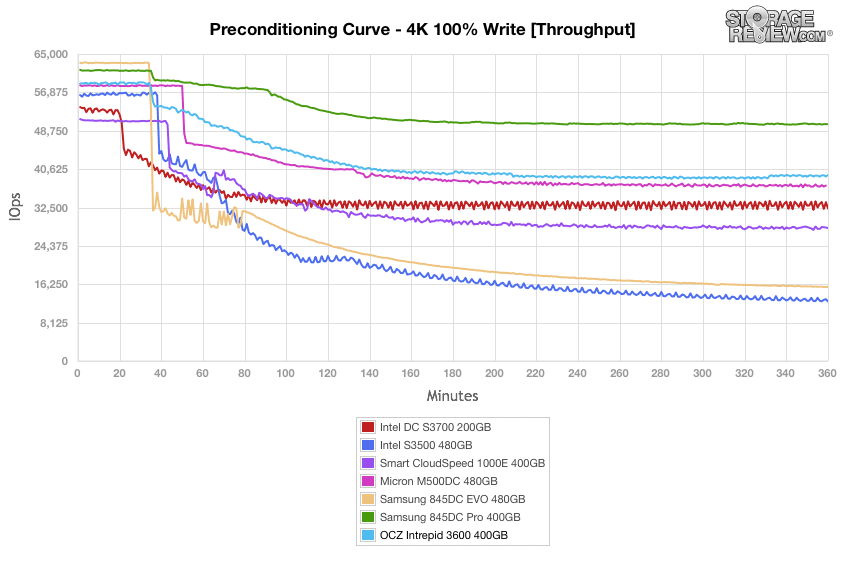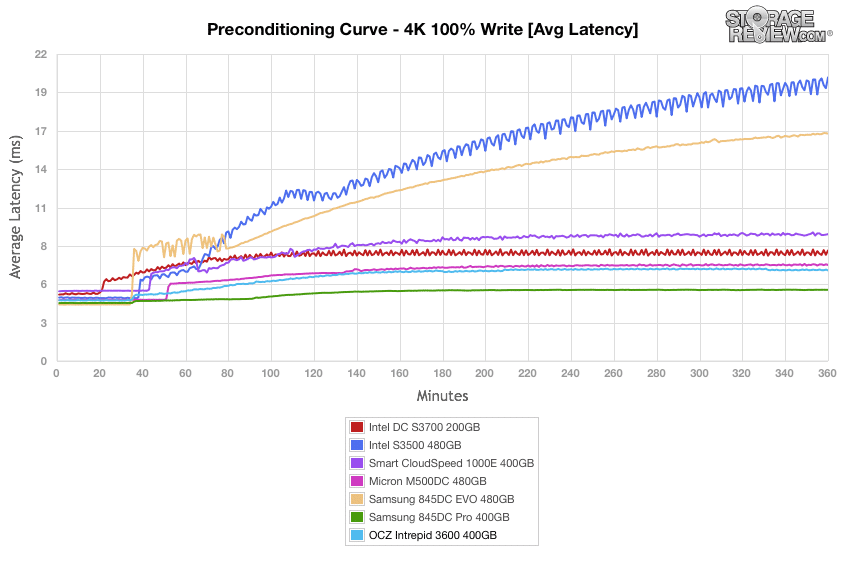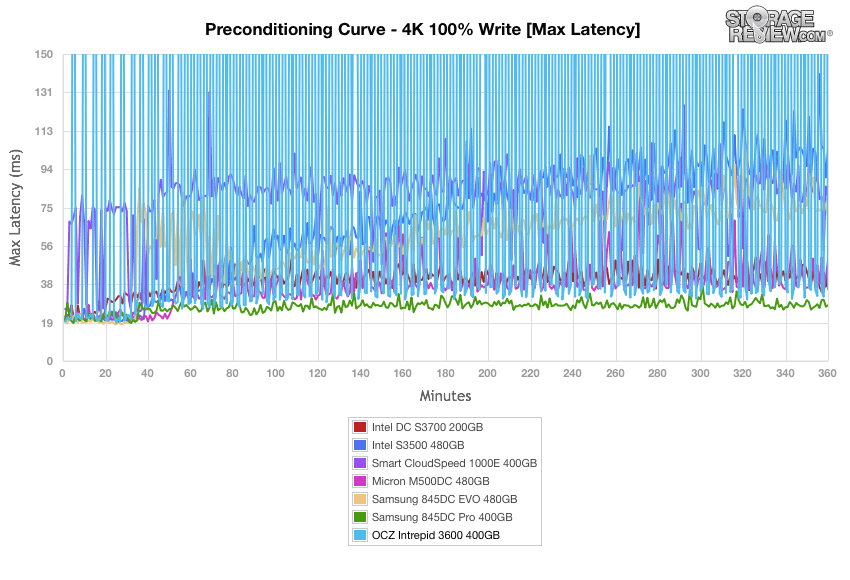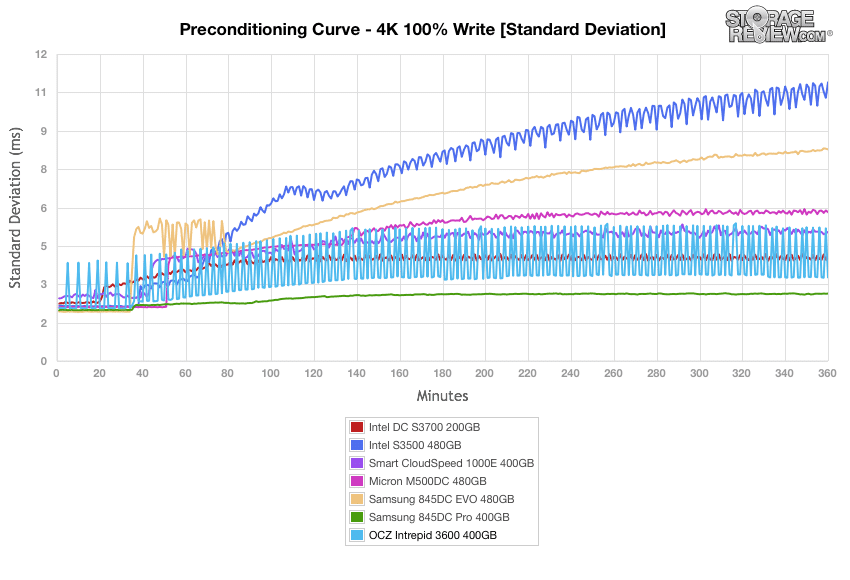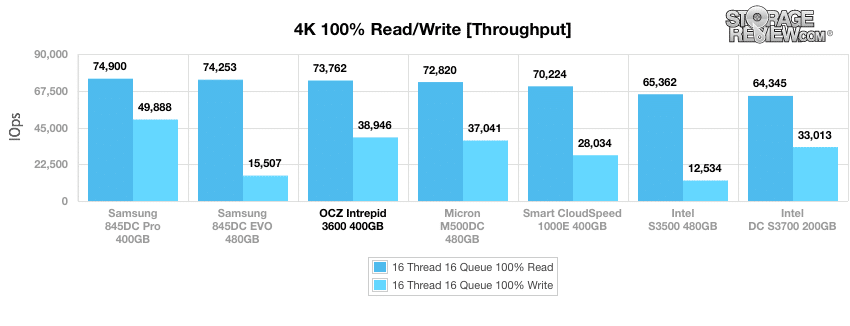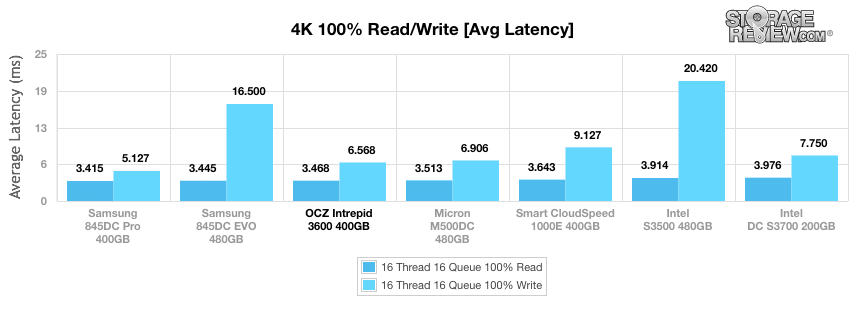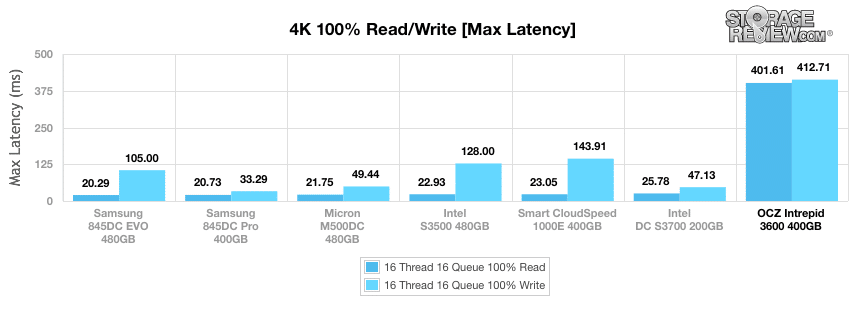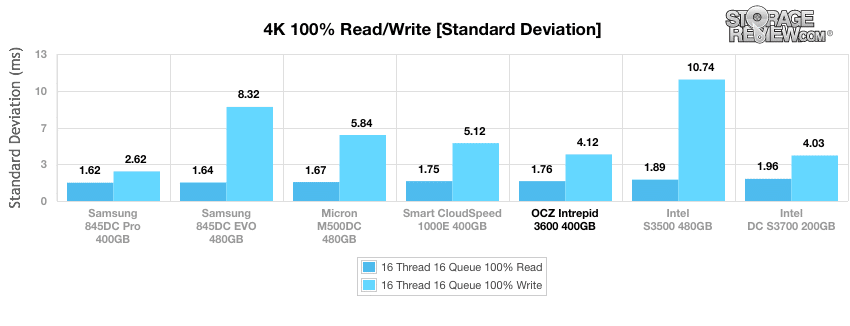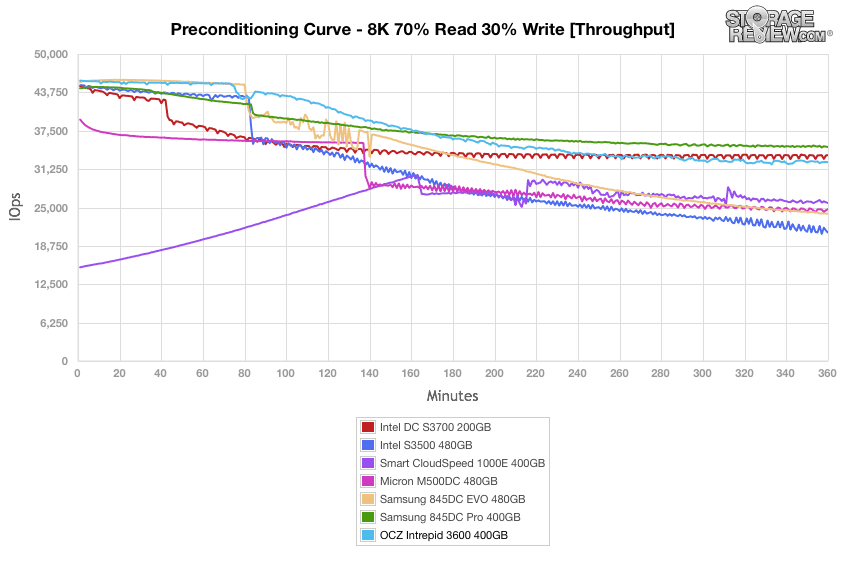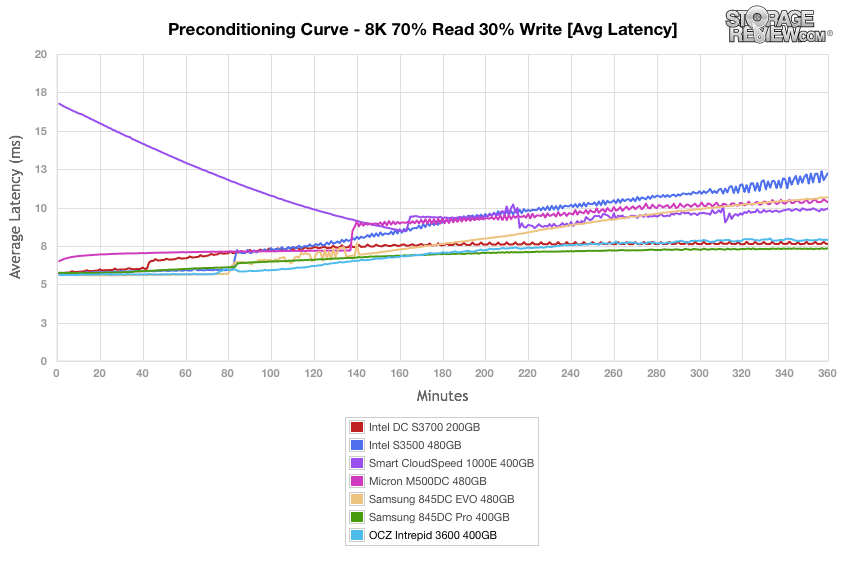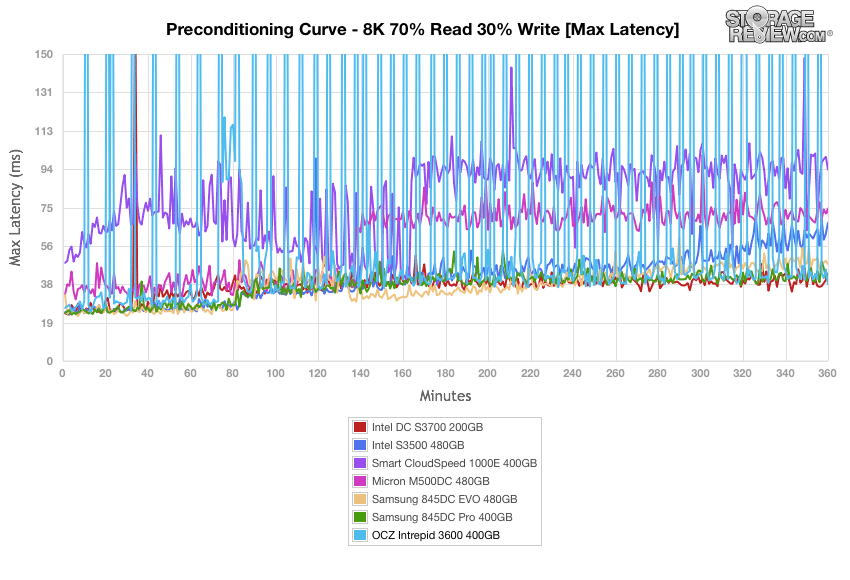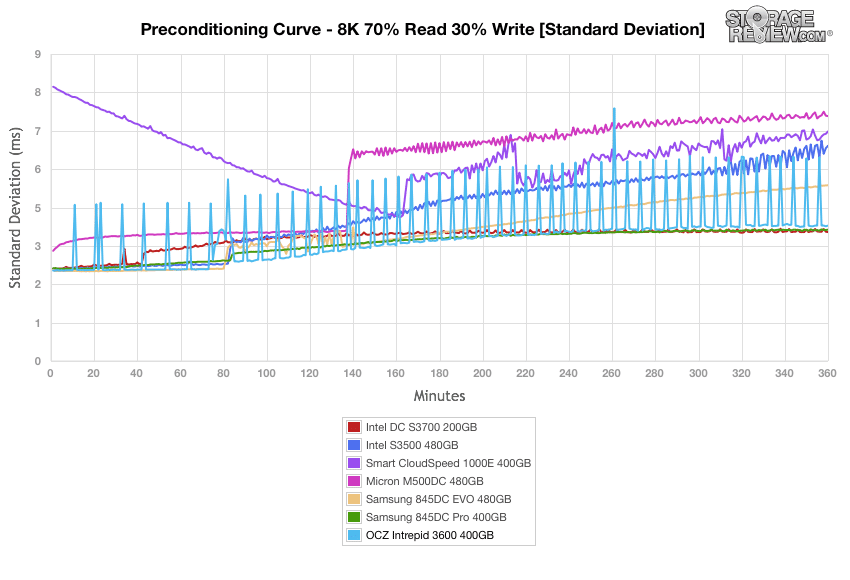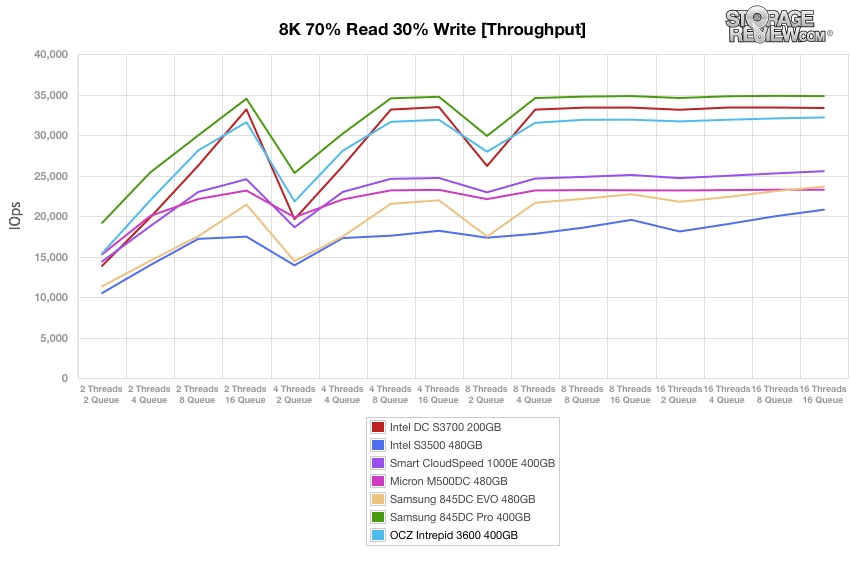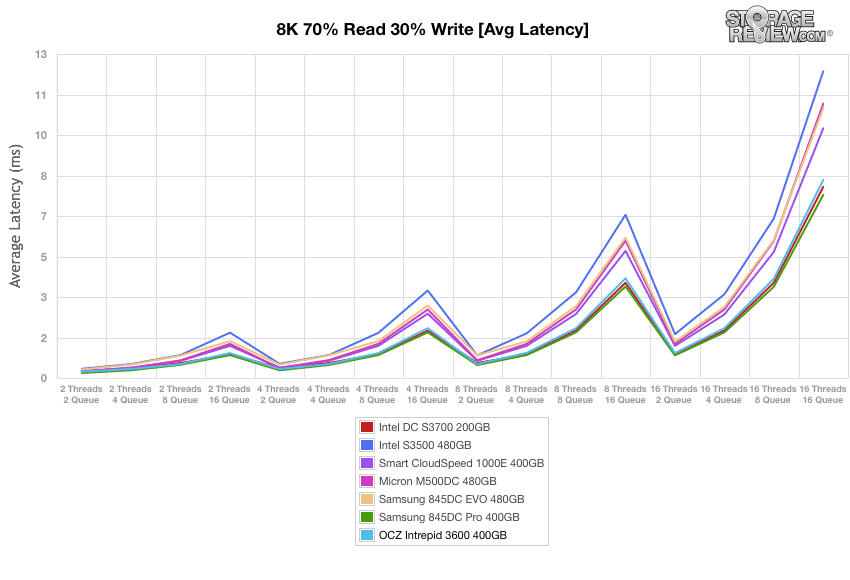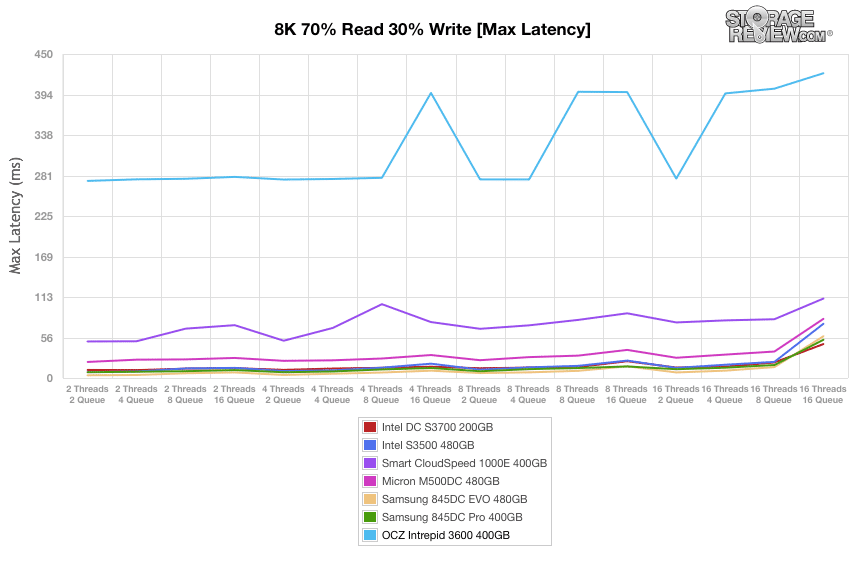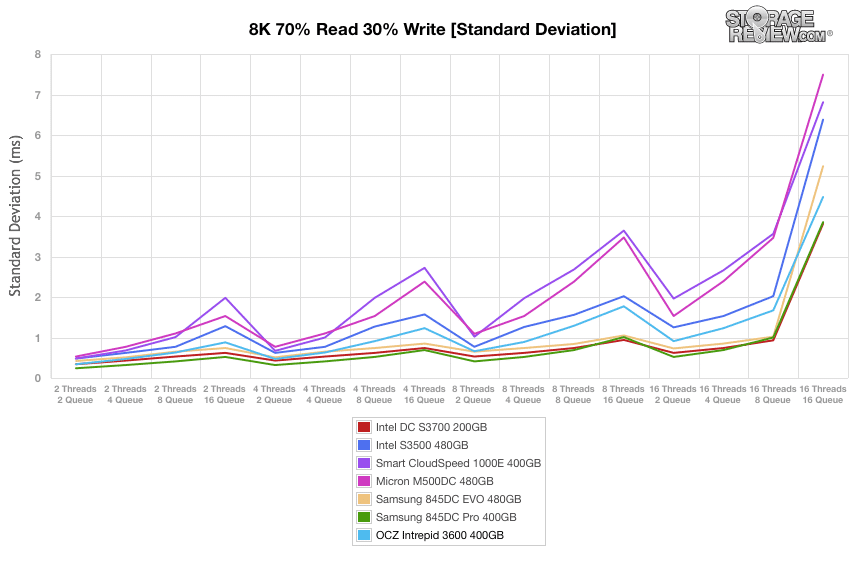The OCZ Intrepid 3600 is an enterprise-class SSD designed specifically for workloads like transaction processing, VM infrastructure, and email servers, while featuring advanced enterprise-grade functionality with a focus on performance, endurance, and reliability. The Intrepid 3000 Series also supports the industry standard 2.5-inch form factor and consists of two configurations: the Intrepid 3600 line, which takes advantage of reliable and cost-effective MLC NAND media, and the Intrepid 3800 line which features high endurance eMLC NAND media. OCZ has also put an emphasis on sustained performance and consistent I/O responses both of these SSDs.
The OCZ Intrepid 3600 is an enterprise-class SSD designed specifically for workloads like transaction processing, VM infrastructure, and email servers, while featuring advanced enterprise-grade functionality with a focus on performance, endurance, and reliability. The Intrepid 3000 Series also supports the industry standard 2.5-inch form factor and consists of two configurations: the Intrepid 3600 line, which takes advantage of reliable and cost-effective MLC NAND media, and the Intrepid 3800 line which features high endurance eMLC NAND media. OCZ has also put an emphasis on sustained performance and consistent I/O responses both of these SSDs.
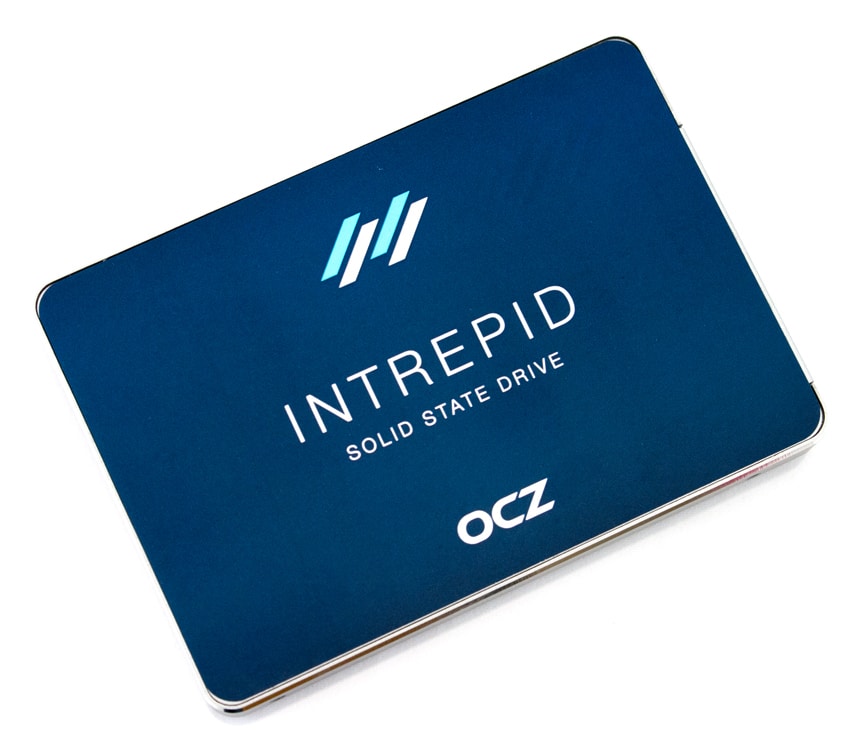
Under the hood, OCZ leverages the Everest 2 Platform with their new line of SSDs, which is a combination of the Marvell 88SS9187 controller and OCZ’s proprietary firmware consisting of advanced flash management and endurance capabilities that extend NAND flash life and enhance drive reliability. This is a move away from SandForce technology that OCZ has used in enterprise drives in the past, to a well-known entity and the same controller that resides inside the Micron M500DC and various SanDisk offerings. It is more than likely however that OCZ went this route as a stopgap until their newest enterprise silicon is ready. Ultimately drives that can use their own controllers are more flexible from an engineering perspective and offer other benefits from a cost perspective.
The Intrepid 3600 SSD includes variety of other features to ensure data integrity. This includes multi-level BCH error correction coding (ECC), which allows the SSD to correct errors up to 85 bits per 2Kb of data all the while reducing the uncorrectable bit error rate (UBER). In addition, its end-to-end data path protection performs data integrity checks at every juncture where data is transmitted, received, processed and stored, helping to ensure that corrupted data is spotted before it can spread. The Intrepid 3600 SSD features in-flight data protection, which prevents data loss when sudden power losses occur by assuring that in-progress write operations complete, as well as properly stored, in SSD flash. Internal SSD RAID redundancy, lower write amplification, and 256-bit AES encryption compliance for data security are also important features to increase longevity. The 3600 posts impressive endurance figures as well, with support for 1498 TBW in the 800GB drive. By comparison the 3800 series drive in 800GB offers 7485 TBW.
The Intrepid 3600 SSDs are backed by a 5-year warranty and comes in capacities of 100GB, 200GB, 400GB, and 800GB. We will be looking at the 400GB unit.
Intrepid 3600 SSD Specifications
- Usable Capacities (IDEMA): 100GB / 200GB / 400GB / 800GB
- NAND Components: 19nm Multi-Level Cell (MLC)
- NAND Controller: Marvell 88SS9187 with OCZ Enterprise Firmware
- Interface: Serial ATA (SATA) 6Gb/s
- Form Factor: 2.5-inch
- Dimensions (L x W x H): 69.75mm x 100mm x 9.20mm
- Weight: 102g (weight varies by capacity)
- Performance:
- Sustained Sequential Read:
- 400MB/s (100GB)
- 475MB/s (200GB)
- 515MB/s (400GB)
- 510MB/s (800GB)
- Sustained Sequential Write:
- 265MB/s (100GB)
- 405MB/s (200GB)
- 465MB/s (400GB)
- 465MB/s (800GB)
- Sustained 4K Random Read:
- 77,000IOPS (100GB)
- 92,000IOPS (200GB)
- 90,000IOPS (400GB)
- 90,000IOPS (800GB)
- Sustained 4K Random Write:
- 21,000IOPS (100GB)
- 31,000IOPS (200GB)
- 38,000IOPS (400GB)
- 38,000IOPS (800GB)
- Sustained Sequential Read:
- Endurance:
- 100GB: 184 TBW
- 200GB: 379 TBW
- 400GB: 784 TBW
- 800GB: 1498 TBW
- Power Consumption: Idle 2W (Typical) / Active 3.4W (Typical)
- Operating Temperature: 0°C ~ 70°C
- Storage Temperature: -45°C ~ 85°C
- Certifications and Declarations: CE, FCC, KCC, C-Tick, BSMI, VCCI, UL, Microsoft WHQL, SATA IO
- Product Ecological Compliance: RoHS
- MTBF: 2 million hours
- Bit Error Rate (BER): 1 sector per 10-17 bits read
- Power Fail Protection: Full in flight data protection for unexpected system power loss
- Data Path Protection: End to End protection via CRC
- Data Encryption: 256-bit AES-compliant
- Product Health Monitoring: Self-Monitoring, Analysis and Reporting Technology (SMART) Support with enterprise attributes
- Serial ATA (SATA): Serial ATA Revision 3.0. Fully compliant with ATA/ATAPI-8 Standard Native Command Queuing (NCQ)
- Power Management: Supports ATA Power Management Specification
- Performance Optimization: TRIM (requires OS support)
- Optimize Sustained Latency Performance: Consistent latency IO operations regardless of data entropy
- Temperature Sensor: Temperature Monitoring & Logging
- Services & Support: 5 year warranty; Dedicated FAE support
Design and build
The Intrepid 3600 looks very different compared to other OCZ SSDs, with the exception of the ARC 100, which uses a similar color scheme. The new design is very nice, with the entire front of the drive covered in a dark blue backdrop with a metallic casing for the entire body. The front of the drive is also relatively minimalistic, labeling the drive with its Intrepid and OCZ branding in a nice clean. Though you rarely see drives during its entire operating lifespan, it’s always nice to see effort put into its design.
The backside offers an information label, which displays everything users/business may need to know about the Intrepid 3600, including serial numbers, model, barcode, PNs, and so on.
As is standard with most SSDs, the each side profile is equipped with two screw holes, as well on each corner of the bottom of the drive, allowing the drive to be easily mounted. The drive comes in a 2.5″ form factor at 9.2mm in height, which makes it compatible for standard applications.
OCZ used a rather interesting capacitor in the Intrepid 3600. It is both larger in size than many on-board units we’ve seen over the past couple of years and it is replaceable.
The Intrepid 3600 utilizes a Marvell 88SS9187 (with OCZ Enterprise Firmware) controller and 19nm Multi-Level Cell (MLC) NAND.
Application Workload Analysis
In order to understand the performance characteristics of enterprise storage devices, it is essential to model the infrastructure and the application workloads found in live production environments. Our first three benchmarks of the OCZ Intrepid 3600 are therefore the MarkLogic NoSQL Database Storage Benchmark, MySQL OLTP performance via SysBench and Microsoft SQL Server OLTP performance with a simulated TCP-C workload.
Our MarkLogic NoSQL Database environment requires groups of four SSDs with a usable capacity of at least 200GB, since the NoSQL database requires roughly 650GB of space for its four database nodes. Our protocol uses an SCST host and presents each SSD in JBOD, with one allocated per database node. The test repeats itself over 24 intervals, requiring between 30-36 hours total. MarkLogic records total average latency as well as interval latency for each SSD.
The latency results for the majority of operations during our NoSQL benchmark were below 23ms with one high merge write latency spike, which is not uncommon for SSDs. Its performance was a bit under par compared to its competition.
Compared to the Micron M500DC to which the Intrepid 3600 closely compares, the latency results for most operations during the NoSQL benchmark remained at or below 60ms, however the M500DC did experience a moderate number of latency spikes which generally occurred during journal write operations.
The next application benchmark consists of a Percona MySQL OLTP database measured via SysBench. In this configuration, we use a group of Lenovo ThinkServer RD630s as database clients and the database environment stored on a single drive. This test measures average TPS (Transactions Per Second), average latency, as well as average 99th percentile latency over a range of 2 to 32 threads. Percona and MariaDB are using the Fusion-io flash-aware application APIs in the most recent releases of their databases, although for the purposes of this comparison we test each device in their “legacy” block-storage modes.
The Intrepid 3600 performed in the middle of the pack throughout the entirety of the MySQL benchmark with over 1,300TPS at 32 threads workload.
The Intrepid 3600 performed neck and neck with the Samsung 845DC EVO and the Smart CloudSpeed throughout the test, ending up in the middle of the pack.
Our worst-case MySQL latency scenario told a similar story, with the Intrepid 3600 ranking in the middle of the pack just behind the Samsung 845DC EVO. The top performer here was the Samsung PM853T with virtually no change from the 16th to 32nd thread.
StorageReview’s Microsoft SQL Server OLTP testing protocol employs the current draft of the Transaction Processing Performance Council’s Benchmark C (TPC-C), an online transaction processing benchmark that simulates the activities found in complex application environments. The TPC-C benchmark comes closer than synthetic performance benchmarks to gauging the performance strengths and bottlenecks of storage infrastructure in database environments. Our SQL Server protocol uses a 685GB (3,000 scale) SQL Server database and measures the transactional performance and latency with a 30,000 VU Load.
The Intredid 3600’s SQL Server Output TPS continued its middle of the run performance, though there was very little discrepancy between virtually all of the drives.
In our average latency benchmark, the Intrepid 3600 again continued to post average results with an overall average latency of 32ms, which was right bedies the Micron M500DC.
Synthetic Workload Analysis
Our synthetic benchmark protocols each begin by preconditioning the target storage into steady-state with the same workload that will be used to test the device. The preconditioning process uses a heavy load of 16 threads with an outstanding queue of 16 per thread.
- Preconditioning and Primary Steady-State Tests:
- Throughput (Read+Write IOPS Aggregate)
- Average Latency (Read+Write Latency Averaged Together)
- Max Latency (Peak Read or Write Latency)
- Latency Standard Deviation (Read+Write Standard Deviation Averaged Together)
Once preconditioning is complete, each device being compared is then tested across multiple thread/queue depth profiles to show performance under light and heavy usage. Our synthetic workload analysis for the OCZ Intrepid 3600 uses 4k and 8k profiles which are widely used in manufacturer specifications and benchmarks.
- 4k Profile
- 100% Read and 100% Write
- 8K Profile
- 70% Read, 30% Write
- 100% 8K
Before we dive into our synthetic tests, a word of caution. The OCZ Intrepid under load in synthetic tests shows a high amount of latency spikes. This is because OCZ is managing background activities, like garbage collection in a less aggressive manner than other similar class drives. What this gains OCZ is endurance at a cost of perceived latency in synthetic tests. It’s important to understand the difference. OCZ accepts the latency spikes that show in synthetic testing but disputes their impact on real world activities. Of course if you look at our application testing above you’ll see highly competitive latency for real world application tests. Synthetic benchmarks have waning value, which is highlighted even more in this case.
During our 4K preconditioning process, OCZ’s Intrepid 3600 SSD posted impressive numbers right off the bat and was to sustain its ranking all the way to the end with steady state near 40,000IOPS.
The Intrepid 3600 continued its great performance in the preconditioning average latency benchmark with no major leaps in latency, taking second place by the end. The Samsung 845DC Pro was the top performer once again.
Our maximum latency benchmark showed some massive latency flutter throughout the test due to OCZ’s management of background activities mentioned above.
The Intrepid 3600 ranked at the top of the pack by the end of the test; however, it showed very inconsistent performance with variances once again due to managing background activities.
When looking at 4K throughput, the Intredpid 3600 posted great numbers ranking near the top of the pack with a read throughput of 73,762IOPS and a second best write performance of 48,946IOPS.
The Intrepid 3600 continued its good performance with 4K average latency tests, ranking near the top of the pack once again with 3.468ms read and 6.568ms write at 16T/16Q.
In our max latency benchmark, the Intrepid 3600 showed a massive performance hit, taking last place by a significant margin.
The Intrepid drive was back on track when looking at standard deviation, posting decent read and write speeds of 1.76ms and 4.12ms respectively.
Our next workload uses 8k transfers with a ratio of 70% read operations and 30% write operations. In this scenario, the Intrepid started off in first place but dropped down to third near the 280 minute mark where it remained until the end of the test.
The Intrepid 3600 was one of the most consistent performers in our average latency test; however, overall, the 845DC Pro was the top performer.
As was the case in the preconditioned 4K test, the Intrepid drive showed quite a bit of latency flutter in our maximum latency results during our 8k 70/30 preconditioning benchmark for the same reasons.
Standard deviation calculations for the 8k 70/30 preconditioning continued to show the Intrepid 3600 drive with spikes through the benchmark, though that was expected.
Once the drives have been preconditioned, the 8k 70/30 throughput benchmark varies workload intensity from 2 threads and 2 queue up to 16 threads and 16 queue. Here, the Intrepid 3600 continued its good throughput performance from the get go and maintained this performance throughout peaking around 32,000IOPS.
In our average latency test, the Intrepid drive stayed neck and neck with the top of the pack (Intel DC S3700 and Samsung SM853T drives) up until the very end where it ended up third place by a narrow margin.
In our 8k 70/30 max latency, the Intrepid 3600 SSD’s results continued to be affected by OCZ’s background management.
In our last test, which looks at standard deviation, the Intrepid performed near the top of the pack (third place) by the end of the queue depths.
Conclusion
OCZ’s Intrepid 3600 is a 2.5” SATA enterprise-class SSD specifically designed for read-intensive workloads and leverages the Everest 2 platform. This platform is comprised of the Marvell 88SS9187 controller and OCZ’s proprietary firmware of advanced flash management and endurance capabilities, which work to extend NAND flash life and enhance the drive’s reliability. OCZ quotes pretty impressive endurance and reliability numbers with support for 1498 TBW in the 800GB drive and a MTBF rating of 2 million hours. The drive also has low power consumption and full in-flight data protection in the event of sudden power losses, all of which are checklist features that enterprises look for in an SSD.
When looking at its performance, the OCZ Intrepid 3600 offered very strong performance. In addition, OCZ drive was up against some pretty tough competition in an increasingly saturated market of entry-enterprise SSDs. In our SQL Server OLTP testing, the Intrepid 3600 posted numbers right in the middle of the pack, highlighted by its 32ms in latency under a 30,000 VU load. The NoSQL and MySQL numbers were also in a similar range, which is good for an MLC drive with the endurance and cost profile the 3600 offers.
As stated above, the latency flutter in our synthetic tests is due to OCZ designing the Intrepid 3600 to manage background activities during its operation. OCZ also reasons that the drive will gain an improved endurance rating as a result and though this endurance gain comes with the cost of perceived latency in synthetic tests, OCZ disputes its actual impact on real world activities. This is a claim that bares a lot weight, all you have to do is look at the drive’s application testing results to see that it posts competitive latency in our real world application tests. It also should be noted that the Intrepid SSDs have a much higher endurance rating with this type of architecture, 1426 TBW for the 800GB. Compared to the 800GB models of Intel DC S3500 and Micron M500DC SSDs, which have a TBW of 450 and 1,900 respectively, this is pretty competitive.
Pros
- Strong real-world application performance
- End-to-end data path protection, power fail protection
- Competitive endurance compared to other read-centric enterprise SSDs
Cons
- Higher peak latency in synthetic benchmarks
Bottom Line
With a wide range of useful enterprise functionality and the application performance to back it up, the OCZ Intrepid 3600 is a viable option for businesses looking for a reliable yet cost effective entry-enterprise SSD.


